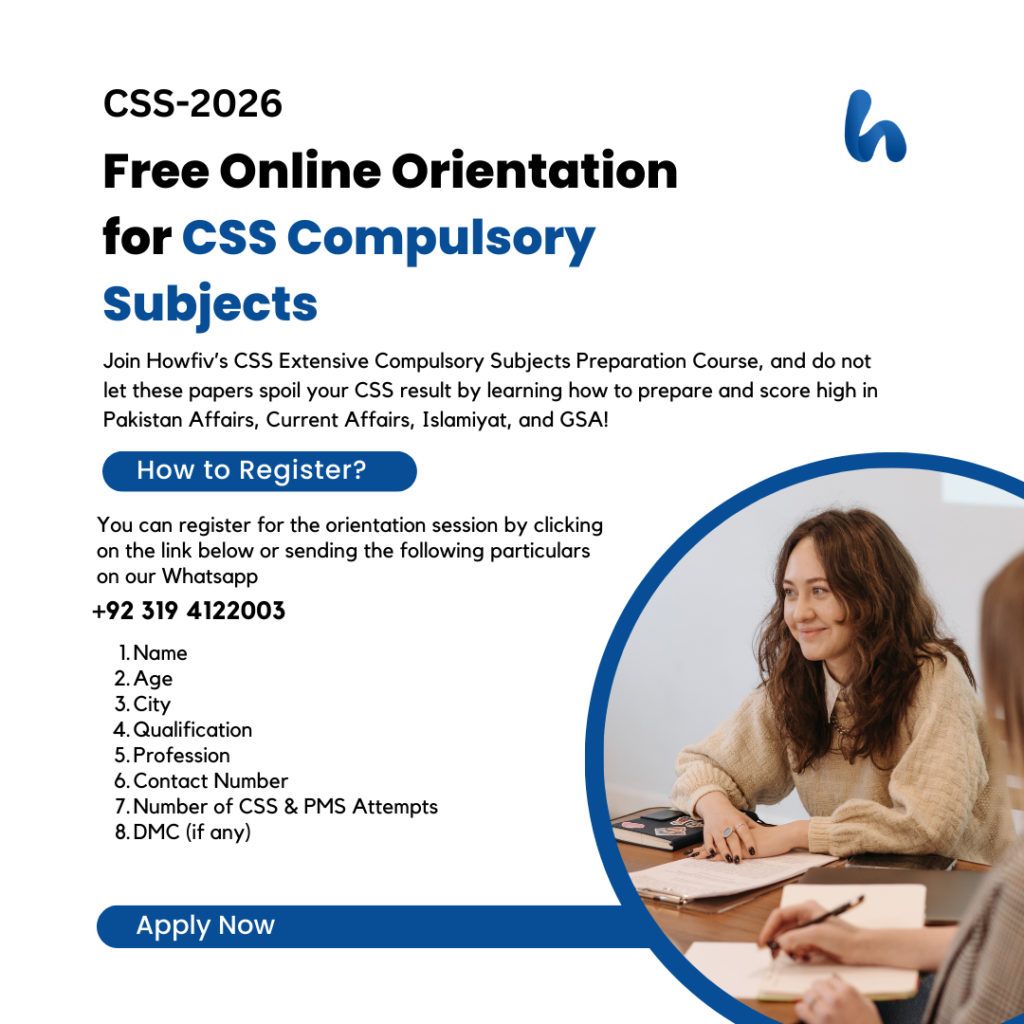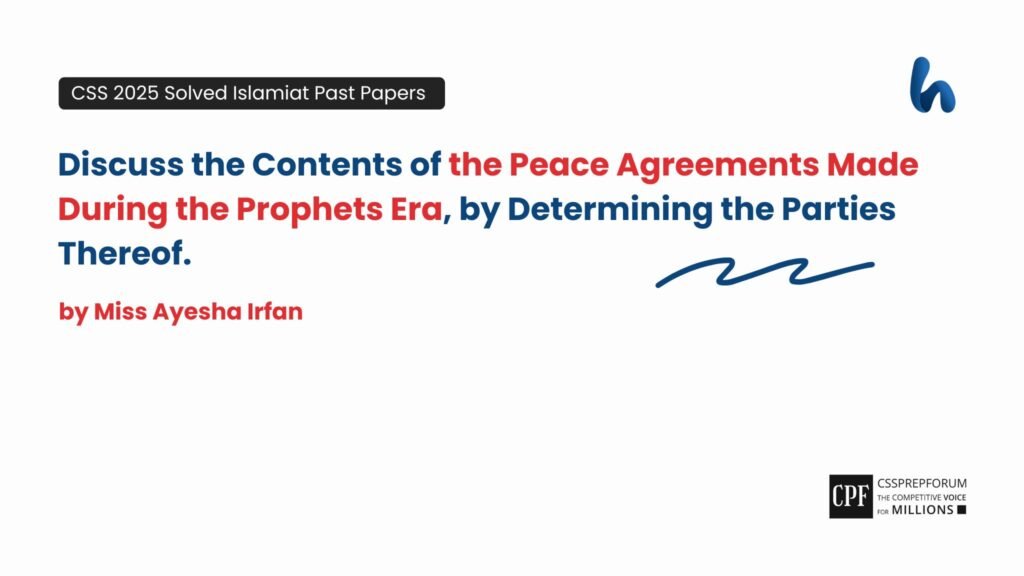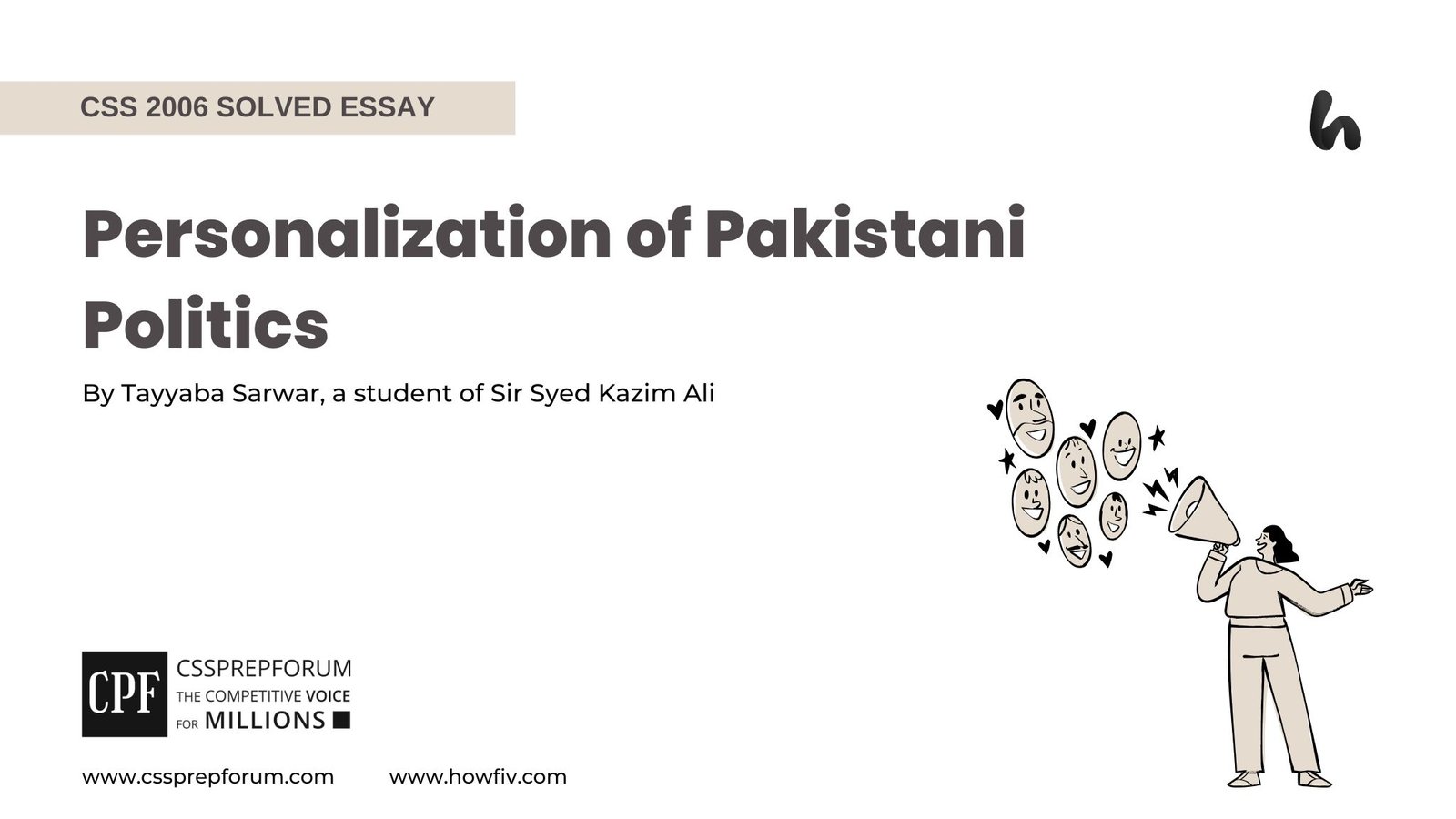CSS 2025 Solved Islamiat Past Papers | The Contents of the Peace Agreements
The following question of CSS Islamiat 2025 is solved by Miss Ayesha Irfan, the highest scorer in CSS Islamiat. Moreover, the question is attempted using the same pattern taught by Sir Syed Kazim Ali to his students, who have scored the highest marks in compulsory subjects for years. This solved past paper question is uploaded to help aspirants understand how to crack a topic or question, write relevantly, what coherence is, and how to include and connect ideas, opinions, and suggestions to score the maximum.

Question Breakdown
The examiner has asked to discuss the contents of the Peace Agreements made during the Prophet era. The question is divided into three sub-parts. First, you must provide an overview of the reasons for the Prophet’s Peace Agreements. Second, describe the contents of Peace Agreements made during the Prophet era. Third, these agreements’ benefits are provided, followed later by Caliphates and Muslim Ummah. Finally, end your answer with a critical analysis and a conclusion.
Outline
1-Introduction
2-A Critical Overview of Conflicts that Lead to the Prophet’s Peace-Making Agreements
3-Contents of Peace Agreements During the Prophet’s (PBUH) Era
- ✓Conductance of Treaty of Hudaybiyyah
- ✓Establishment of Meethaq-e-Madinah
- ✓Foundation of Al-Aqaba Pledges
- ✓Correspondence with different Arabian tribes
- ✓Consensus with the Christian community of Najran
- ✓Establishment of Brotherhood
4-Benefits and Consequences of the Prophet’s Peace Agreements
- ✓Establishment of diplomatic relations and expansion of Islam across the Arabic peninsula
- ✓Strengthen Islamic governance and ensure political stability
- ✓Contribution to the peaceful conquest of Makkah
- ✓Emergence of a sense of tolerance towards other religions
5-Critical Analysis
6-Conclusion

Answer to the Question
Introduction
Islam is a peaceful religion, and its teachings are based on this principle. Likewise, the life of Hazrat Muhammad (PBUH) is itself a testament to the fact that Islam is a religion of peace, tolerance, acceptance, and forgiveness, no matter how harsh and violent the situation is. Before the advent of Islam, the Arabs were indulged in multiple conflicts and rivalries, so to bring stability, the Prophet’s peace-making agreements are proof that even Muslims were tortured, socially boycotted for three years, and faced difficulties in the region, he declared that no one would harm the after war prisoners and pardon them. The peace-making agreements carried out in the Prophet’s era include the treaty of Hudaybiyyah, Meethaq-e-Madinah, Al-Aqaba pledges, and consensus with multiple tribes. Undoubtedly, these agreements have changed the perspective of the Arabian peninsula, as these agreements have brought peace and stability in the region, established brotherhood between the rival tribes, promoted economic equality, taught tolerance for other religions, and ensured social co-existence.

A Critical Overview of Conflicts that Lead to the Prophet’s (PBUH) Peace-Making Agreements
Before the Prophet’s peace-making efforts and agreements, the Arabs were involved in different conflicts, causing regional instability. Multiple factors have infused these instabilities. One of the significant factors was the long-standing conflict between the Aws and Khizraj tribes, which led to the region’s destabilisation. Moreover, the Arabs considered Muslims as a threat to their political power and regional dominance, which led to the migration of Muslims to Abyssinia due to oppression. Adding more to it, Quraysh were dominant in trade in Makkah, but due to the advent of Islam, they took Islam as a threat to their economic might, leading to the three-year imposition of a boycott on the Prophet’s (PBUH) family, the Banu Hashmi, by isolating them in a valley and cutting their foods as well. Other than that, a fragmented society has fueled internal conflicts with Muslims in Medina over political control and alliances. All these conflicts have become a reason for the Prophet’s (PBUH) peace-making agreements with non-Muslims to bring stability to the region, promote economic equality, and inculcate tolerance towards other religions.
Contents of Peace Agreements During the Prophet’s (PBUH) Era
After taking an overview of the condition of the the Arabian peninsula and discussing the factors behind the instability in the region, it is pertinent to discuss the key contents of Peace-making agreements carried out in the Prophet’s (PBUH) era to bring stability, ensuring economic equality, and creating a a social connection for peaceful co-existence.
- ✓Conductance of Treaty of Hudaybiyyah
When the ProphetProphet Muhammad (PBUH) and approximately 1400 Muslims went to Mecca to perform a pilgrimage, the Quraysh considered it as a threat of invasion and stopped them at the place of Hudaybiyyah near Mecca. Consequently, a resolution, named the Treaty of Hudaybiyyah, was initiated between them to avoid the threat of war. The main contents of the treaty are discussed as follows. First, Muslims would not perform pilgrimage this year but could accomplish it in the next year. Second, there would be no war between the two parties for a decade. Third, any person from Mecca who converted to Islam and fled to Madinah must be returned to Mecca, but if any Muslim went to Madinah, it would not be returned by Quraysh. Lastly, Muslims and the Quraysh would not attack each other or their allies. Ibn Shihab al-Zuhri, an esteemed scholar, highlighted the significance of the Treaty of Hudaybiyyah by stating, “No previous victory in Islam was greater than this. The alliance allowed people to interact safely, leading many to embrace Islam upon understanding its teachings.”
- ✓Establishment of Meethaq-e-Madinah
Meethaq-e-Madinah, the Constitution or charter of Madinah, was an agreement formulated by the Prophet (PBUH) after he migrated to Madinah, and the parties involved were Muslims, the Jewish tribe of Madinah-including Banu Nadir, Banu Qurayza, and Banu Qaynuqa, and Pagan Arab tribes. It was a multi-religious and multi-tribe governance system, ensuring cooperation, equality, peace, and security among the people of Madinah. The key contents of the pact are stated as follows. First, all signatories must be considered one nation and would protect Madinah from external threats, regardless of religion and tribe. Second, all tribes, Muslims or non-Muslims, can practice their faith and deal with internal matters. Third, in case of group conflict, the matter would be referred to the ProphetProphet Muhammad (PBUH) for arbitration. Fourth, fair compensation and justice would be followed for everyone equally. Lastly, the society would not betray or break the pact and be responsible for protecting the weak. Dr. Muhammad Hamidullah, a renowned 20th-century scholar, highlighted the significance of the Constitution, “It is the first written constitution in human history, establishing a pluralistic state where different tribes live together under a unified governance system.”
- ✓Foundation of Al-Aqaba Pledges
The pledges of Al-Aqaba are two secret peace agreements between the Prophet Muhammad (PBUH) and the people of Yathrib, Madinah. Before these pledges, the Prophet (PBUH) faced persecution by the Quraysh and the people of Madinah suffered from tribal conflicts like between Aws and Khizraj. Consequently, when the people of Yathrib met with Muhammad (PBUH), they were impressed by the teachings of the Prophet (PBUH) and pledged their support to him. Prophet (PBUH) recited verses of the Quran, calling People unto Allah and encouraging them to accept Islam; in response, one of the attendees, Al-Bara’ bin Ma‘rur, affirmed their commitment by saying, “We give our allegiance, O Messenger of Allah. By Allah, we are men of war possessing arms which have been passed on from father to son.” The first pledge of Al-Aqaba was between the Prophet Muhammad (PBUH) and twelve men from Yathrib, 10 from Khizraj and two from Aws. The main points of the first Al-Aqaba pledge include believing in the oneness of Allah, obeying the teachings and guidance of the Prophet (PBUH), avoiding committing crimes, such as theft, adultery, and murder, and speaking the truth and refraining from lying. The second pledge of Al-Aqaba was pledged between the Prophet Muhammad (PBUH) and 75 people from Yathrib, 73 men and two women. The main contents of the second pledge of Al-Aqaba include giving full support to Islam and defending Islam and Muhammad (PBUH) at the cost of their lives, protecting Muslims to protect their families, providing a commitment to the war against the enemy of Islam, and following the instructions of Islam by heart.
- ✓Correspondence with Different Arabian Tribes
During the Prophet Muhammad (PBUH) era, multiple correspondences were sent to expand Islam and establish peace across the Arabian peninsula. These letters play a significant role in establishing diplomatic ties and securing allies. After confirming the first Islamic state in Madinah, Muhammad (PBUH) has committed their efforts to expand Islam beyond Madinah. In this regard, letters were sent to Banu Hanifa and Banu Tamim tribes, inviting them to accept Islam. According to Sahih Muslim, Hazrat Aisha (R.A) narrated that, “When the verse ‘And warn your tribe of near kindred’ from the Quran (26:214) was revealed, the Messenger of Allah (PBUH) stood up on Mount Safa and called out ‘O Fatimah, daughter of Muhammad. O Safiyyah bint Abd-al-Muttalib. O sons of Abd al-Muttalib…’ He continued to address various clans of Quraysh, urging them to accept Islam.” Likewise, the key contents of the correspondence are as follows. First, they were invited to Islam. Second, the teaching of emphasis on monotheism and rejection of idolatry were provided. Lastly, a promise was made to ensure peace and prosperity under Islamic rule. As an outcome, some members of Banu Hanifa accepted Islam, while initially, Banu Tamim resisted the invitation. However, later, they embraced Islam wholeheartedly.
- ✓Consensus with the Christian Community of Najran
The agreement between the Prophet Muhammad (PBUH) and the Christian community of Najran is a diplomatic alliance which ensures the peaceful co-existence of Muslims and Christians. The agreement is also known as the “Covenant of Najran” or “Treaty 1 of Najran”. The Prophet Muhammad (PBUH) sent a letter inviting Christians of Najran to accept Islam. Several negotiations were carried out between both parties, but failed to reach cooperation; however, they agreed on mutual peaceful co-existence under the protection of Muslim rule. The main contents are stated as follows. First, Christians were invited to Islam. Second, they were offered to live peacefully under Islamic rule even if they remained Christian. Third, assurance of religious freedom was provided under an Islamic state. As a result, the Christian tribe decided to remain Christian but accepted to live under Muslim protection by paying Jizya, a tax for non-Muslims under the Muslim government. Ibn Ishaq, an 8th-century historian and hagiographer, narrates in his biography “Sirat-e-Rasul Allah” that a delegation of Christians from Najran visited the Prophet in Medina. During their stay, when their prayer approached, they began to pray inside the Prophet’s mosque, facing east. Some companions intended to stop them, but the Prophet (PBUH) instructed, “Let them [pray].” It highlights the Prophet’s respect for the religious practices of others.
- ✓Establishment of Brotherhood between Muhajireen and Ansar
Peaceful agreements have established brotherhood among tribes, aiming to provide cooperation, social co-existence, and a harmonious and just society. After migration from Mecca to Madinah, there was a need to ensure collaboration between migrants (Muhajireen) and the local Muslims (Ansar). Therefore, the Prophet (PBUH) initiated multiple peace agreements to promote brotherhood. The main contents of the agreement are stated as follows. First, Ansar would share their homes, food, and land with their Muhajireen brothers. Second, they would be bound to defend each other from external threats or in times of war. Third, brotherhood should be based on faith, not on tribal ties. In this regard, Islamic scholar Dr Muhammad Hamidullah highlighted the significance of the brotherhood by stating that “It was a unique social contract that transcended tribal affiliations and economic disparities, providing immediate relief to the emigrants but also laid the foundation for a cohesive and resilient Muslim society in Medina.”
Benefits and Consequences of the Prophet’s Peace Agreements
The Prophet’s peace agreements have a significant role in shaping the core of Islamic history, evidenced by the benefits and consequences of these agreements.
- ✓Establishment of Diplomatic Relations and Expansion of Islam Across the Arabic Peninsula
The Prophet’s (PBUH) peaceful agreements also established diplomatic ties among tribes. Prophet Muhammad (PBUH) sent letters to rulers like the Byzantine Emperor and the Persian Sassanian Emperor, inviting them to accept Islam and establish diplomatic ties, a good example of establishing diplomatic relations with influential tribes across Arabia. Consequently, it also inspired the Caliphate to expand Islam beyond Arabia. Hence, these agreements become the reason for the expansion of Islam at the global level.
- ✓Strengthen Islamic Governance and Ensure Political Stability
The peace agreements played a crucial role in the emergence of the first-ever Islamic state, which later became a diplomatic model for the Caliphates to learn and seek guidance. For instance, it is evident from establishing the Charter of Madinah, a unified pact where multiple tribes coexisted regardless of their religion and tribes. Hence, peace-making agreements have brought Jews, Muslims, and Christians into one place, established political stability, and ensured regional cooperation.
- ✓Contribute to the Peaceful Conquest of Makkah and the Expansion of Islam
The peaceful agreements have led to the expansion of Islam carried out with diplomacy instead of forced conversions. To illustrate, a mutual agreement was signed between the two parties for cooperation, but the opponents broke the Treaty of Hudaybiyyah by violating the agreement. As a result, the Prophet (PBUH) took 10,000 troops for the peaceful conquest of Mecca, and he (PBUH) also forgot enemies without any conflict, resulting in the wholehearted acceptance of Islam. Hence, this incident elaborates that peace agreements made during the Prophet (PBUH) era led to the peaceful Mecca conquest and expansion of Islam.
- ✓Emergence of Sense of Tolerance towards Other Religions
The peace agreements between Muslims and non-Muslims ensured religious tolerance for other religions. One such example is the peaceful co-existence of the Christian tribe of Najran and Muslims living together peacefully under Islamic rule. Also, it ensures the importance of the protection of minorities’ rights in the Islamic State. They can practice their religion freely and resolve internal matters with complete freedom. Thus, such cooperation brought religious tolerance and social unity.
Critical Analysis
To evaluate critically, the Prophet’s (PBUH) peace agreements have brought a ray of light in the darkest of times when Arabs were engaged in tribal conflicts and rivalries, as between the Aws and Khizraj tribes. There was religious intolerance among different parties, but by signing the peace agreement with the Christians of Najran, the Prophet ( PBUH) united all tribes under one state by promising the protection of their religious freedom. All these peace agreements have contributed to strengthening diplomatic ties, promoting religious tolerance and unity, and peaceful expansion of Islam.
Conclusion
Summing up the whole debate, Islam is a peaceful religion, and the Prophet (PBUH) is the strongest advocate of Islam. Before the advent of Islam, the Arabs were occupied in different tribal conflicts, social disharmony, and economic indifferences. However, the Prophet’s peace agreements, such as the treaty of Hudaybiyyah, Meethaq-e-Madinah, and Al-Aqaba pledges, all contributed to the peaceful co-existence of the Islamic state in Madinah. These treaties have created hope for the Caliphates to expand Islam across Arabia and maintain peace through cooperation by avoiding violence at any cost. Thus, these agreements brought unity among different groups and promoted the expansion of trade by developing diplomatic ties with the neighbouring areas.

CSS 2025 Solved Islamiat Paper
Searching for CSS or PMS Solved Islamiat Past Papers?
Are you preparing for CSS or PMS and searching for solved Islamiat past papers, notes, books, PDFs, and MCQs? Explore them for free on Howtests and Cssprepforum. All content is fully solved and written by Miss Ayesha Irfan. For your convenience, the links are provided below, simply click on any to start reading and preparing.












